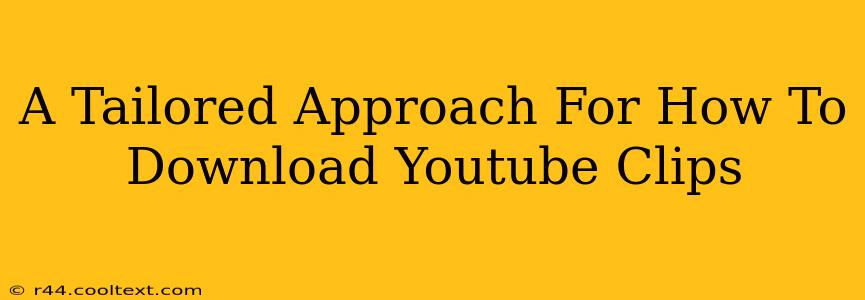Downloading YouTube clips can be tricky, and the methods you use should always respect copyright laws and the creators' wishes. This guide offers a tailored approach, walking you through ethical and legal options for getting the videos you need. We'll avoid any methods that violate YouTube's Terms of Service or infringe on copyright.
Understanding Copyright and Fair Use
Before we delve into methods, let's clarify the legal landscape. Downloading copyrighted YouTube videos without permission is illegal in most jurisdictions. However, the concept of "fair use" allows for limited use of copyrighted material under specific circumstances. These circumstances usually include:
- Criticism and commentary: Using a clip to analyze or critique the original video.
- News reporting: Incorporating short clips into news reports.
- Education: Using clips for educational purposes in a classroom setting.
- Parody: Creating a parody that transforms the original work.
Important Note: Even if your use falls under fair use, it's crucial to use only the necessary portion of the video and properly attribute the original creator.
Ethical and Legal Methods for Accessing YouTube Videos
While directly downloading a YouTube clip might seem straightforward, the ethical and legal options provide a safer and more responsible way to access the content you need:
1. YouTube's Built-in Features
YouTube offers several features that can help you achieve your goals without resorting to third-party downloaders:
- Saving to a Playlist: Create a playlist of your favorite videos for easy access later. This keeps the videos within the YouTube ecosystem.
- YouTube Premium: A paid subscription service offers ad-free viewing and offline downloads, allowing you to watch content without an internet connection. This is an excellent option if you frequently watch the same videos.
2. Contacting the Uploader
If you need a specific clip for a project and have exhausted other options, reach out to the uploader directly. Many creators are happy to share their work for legitimate purposes. Simply send a polite email explaining your needs and requesting permission to use their video.
3. Using Screen Recording Software
For short clips or snippets, screen recording software can be a viable solution. This captures what you see on your screen, allowing you to record specific sections of the YouTube video. Remember, this is only suitable for short clips and personal use, not for large-scale distribution. Popular screen recording options include OBS Studio and QuickTime Player (for Mac).
4. Seeking Alternatives
Instead of downloading, consider using embed codes to integrate videos directly into your website or blog. This allows viewers to watch the content within the YouTube platform while promoting the original creator.
Why Avoid Illegal Download Methods?
Using unauthorized downloaders or websites can expose you to several risks:
- Malware and viruses: Many unofficial download sites are riddled with malware that can infect your computer.
- Legal repercussions: Downloading copyrighted content without permission can lead to legal action from the copyright holder.
- Ethical concerns: It's unethical to download content without the creator's consent, depriving them of views and potential revenue.
Conclusion
Accessing YouTube clips responsibly requires careful consideration of copyright laws and ethical practices. While quick downloads might seem appealing, using official methods and respecting creators is paramount. By adopting a tailored approach that prioritizes legal and ethical considerations, you can enjoy the content you need while protecting yourself and supporting creators.

